
The most commonly studied EPN’s are those that can be used in the biocontrol of harmful insects, which are the members of Steinernematidae and Heterorhabditidae. They are highly diverse, complex, and specialized. EPNs have been found all over the world and in a range of ecologically diverse habitats.

They can infect many other different types of insects that are living in the soil like flies, butterflies, the larval forms of moths, and beetles. Although many other parasitic threadworms can cause diseases in living organisms, the entomopathogenic nematodes are specific in infecting only insects.Įntomopathogenic nematodes (EPNs) live inside the infected insect host parasitically, and thus they are termed endoparasitic. These are habitually grouped with pathogens because of their symbiotic relationship with bacteria. These animals are present in between microbial pathogens, parasitoids, and predators. The term entomopathogenic has a Greek origin, where the ‘entomon’ means insect, and pathogenic means causing disease. A variety of biological controls are easily available for use, but further development and effective adoption of these techniques will require a greater understanding of the complex interactions among people, plants, and the environment.Įntomopathogenic nematodes (EPN) are a group of nematodes also called threadworms, these can cause death to insects. The biological control of plant diseases is the alternative way to control pests. Consequently, some of the pest management researchers have focused mainly on their efforts in order to develop alternative inputs to the synthetic chemicals for controlling pests and diseases. However, the environmental pollution that is caused by the excessive use and misuse of certain agrochemicals, has led to considerable changes in the attitude of the people towards the usage of pesticides in agriculture.Īdditionally in natural ecosystems, the spread of plant diseases may prevent the successful application of chemicals, because of the scale to which such applications might have to be applied. Such types of inputs to agriculture have contributed more significantly to the spectacular improvements over the past 100 years in crop productivity and quality. Beyond good agronomic and horticultural practices, the growers often rely majorly on chemical pesticides and fertilizers. Plant diseases need to be controlled in order to maintain the quality and abundance of the food, feed, and fibre that are produced by growers all around the world.ĭifferent approaches may be used to prevent, or mitigate, or control plant diseases.

Organisms that can cause infectious disease include bacteria, fungi, oomycetes, viruses, virus-like organisms, protozoa, phytoplasmas, nematodes, and parasitic plants. Plant pathology is the scientific study of diseases found in plants that are caused by pathogens and some other environmental conditions.

This broadly defines biotic and abiotic plant diseases. Plant disease can be defined as anything that prevents a healthy plant from performing to its maximum potential.


 0 kommentar(er)
0 kommentar(er)
